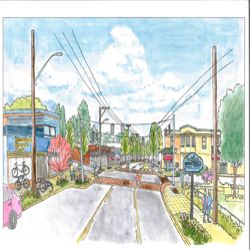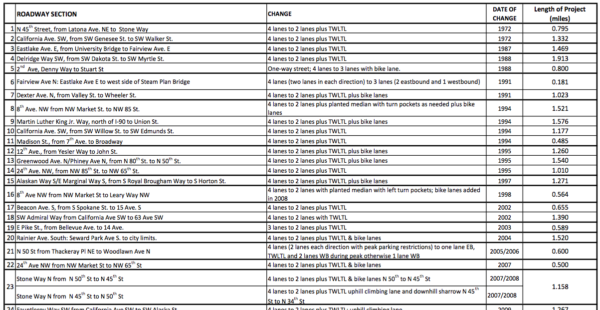 The recent article on the progress of the Montlake Business District Development project has generated several comments about the proposal to reduce traffic lanes from four to three on 24th Avenue E (the “road diet”). The general concern is that this change could result in worsening the traffic back-ups on 24th Avenue E and increase more cut throughs on our residential streets. Certainly none of us want this to happen, and a “road diet” would not occur until SDOT studies its possible effects on cut-through traffic.
The recent article on the progress of the Montlake Business District Development project has generated several comments about the proposal to reduce traffic lanes from four to three on 24th Avenue E (the “road diet”). The general concern is that this change could result in worsening the traffic back-ups on 24th Avenue E and increase more cut throughs on our residential streets. Certainly none of us want this to happen, and a “road diet” would not occur until SDOT studies its possible effects on cut-through traffic.
According to the Walkable and Livability Institute: “Drivers tend to use primary roads that provide the most direct and efficient route to a destination. Well- designed road diets do not divert drivers onto other roads. While traffic often drops during construction, it typically returns to normal or increases within six months of completion. “
Since the 1970’s The Seattle Department of Transportation has completed 40 neighborhood projects that included right sizing or road diets. (Download this PDF to see a List of Projects.) They have found that these “rechannelizations” (or road diets) actually reduce speeds and collisions. They are especially beneficial and safer for pedestrians since they have fewer lanes to cross. It is critically important to ensure we all, especially children, have a safe way to schools, park facilities, transit and shopping. The City has found that significant amounts of diversions do not occur. If it does happen, they can use traffic calming devices like speed bumps, traffic circles or diverters to discourage cut-through traffic.
The reality is that we are an urban neighborhood and traffic will not go away. The entire city is now that way. To reduce congestion the city would need to add capacity with roadway widening and more traffic lanes which it will not do and would not work if we want to have livable residential areas in the city. The city’s policy is shared use streets, providing multi-modal transit and bicycling facilities and making streets safer and more comfortable for pedestrians by reducing speeds and narrowing intersections where they can. The overall result is that commuters have to adapt, use bus or bike instead of cars and understand the commute drive will take more time.
That said, if we want a safe and viable business district that serves and is connected to the Montlake community, we need to find ways to reduce speeding on the 24th arterial which is dangerous to pedestrians, and we need to find ways to support and enhance our business district. Adopting the “road diet” promises to do both if the results of SDOT’s traffic study show Montlake is eligible for this change.
As a longtime resident (living at the corner of 25 Avenue E. and E. Miller Street for 40+ years) I know the frustration of traffic and understand the fear that slowing down traffic in one area can have the unintended consequences of drivers “discovering more convenient routes.” The solution is to develop a traffic calming plan for the residential streets. Representatives from the Montlake Community Club continue to meet with SDOT to discuss this matter. Our goal is to develop a neighborhood wide plan that will eliminate cut through traffic. We will be reaching out to the community to identify the best ways to achieve this goal on a street to street basis.
Living in Montlake should not mean sacrificing the opportunity to develop our business district for fear of increased traffic. We, as a community, are organized and working to find solutions. We want any changes made to re-energize the Montlake business district to work for the entire community.

Paul Freiburger says
I fully agree that the road diet will be horrible. 1) At rush hour there are already more pedestrians, bicyclist, children playing, dog walkers, people out and about on 25th Ave. East than there are on Montlake Blvd. They are the ones that need protection. Montlake gets backed up and people come flying through intersections and tearing down the street on 25th. Several times a month we witness near-misses, and a couple times a year we see collisions between cars and bicyclists. (When the state does it’s study, I hope it’s on a warm day during evening rush hour so they can see just how bad it is, not some rainy cold day in December when fewer people are out.) 2) I question these studies if they conclude that people just passively sit in their cars as traffic gets worse. We’ve lived here for 17 years and we’ve seen a steady increase in people taking side roads to get around traffic as the traffic has gotten worse. It’s very obvious to the people that live here. 3) Conventional wisdom for years has been to funnel traffic onto arterials to make neighborhoods more livable. Montlake Blvd is an arterial, or should be considered an arterial. It is a main route across the cut, to 520, to UW, etc. Montlake and the U bridge are the only real North-South arterials east of I-5. It’s pure fantasy to think drivers will find a better arterial, or just suddenly take the bus or bike (it doesn’t work with many school drop-off schedules, rain, etc.), or just passively sit for longer. The city is actively choking off the few remaining arterials and it is causing drivers to get more aggressive, not more passive. 4) Is the business district hurting? They seem to be doing just fine. There are only a handful of them in “the business district” that would benefit from a road diet anyway. Is it really worth terribly inconveniencing tens of thousands of drivers to make things more pleasant for a handful of people? And I don’t buy the safety argument. More traffic on side roads increases the danger. 5) If this is all about safety then why not invest in overpasses? That would be cheaper, safer and better. You could even take out some traffic lights and improve traffic flow. 6) Has anyone tried to truly survey Montlake residents? Door-to-door or with a mail survey? The handful or people paying attention don’t represent the general population. Everyone we’ve talked to thinks a road diet is mind-bogglingly dumb and no one would be stupid enough to go ahead with it.
Dore says
I fully agree with the comments identifying the negative effects of the road diet: worse backups, side street drive-through issues, worse access to light rail. This place is not a solution. It is a problem!
Barbara Klube says
And also with this backup heading north, this stops buses from getting to the UW Link timely. And there no longer is a southbound #43 bus !!
RTE says
Unfortunately the traffic pattern on 24th needs more than ‘calming.’ At rush hour both N-bound lanes of 24th are needed for ‘holding’ traffic because of the new lights and traffic pattern N-bound at the bridge. If only one lane can be ‘holding’ those cars, then buses will be even slower, and the back-up will be twice as long.
And who in their right mind thinks that with those back-ups, drivers will not use 25th, 26th, and the other N-bound residential streets (no matter what the city’s prior studies said for other areas)?
Everything is green says
We love the idea of a road diet in our business district. It gives it more of a destination, neighborhood feel rather than a pass-through road. But here is a big concern that reducing arterial traffic lanes will encourage cut-through traffic in the neighborhood to a point where gridlock starts to exist on streets where it’s unsafe. Case in point: Our house is on 22nd Ave E which is a bicycle/pedestrian greenway running between Boyer to E. Roanoke St. In busy rush hour(s) when 24th Ave E/E. Montlake Pl E arterial is backed up, we see traffic on 22nd Ave E for blocks. These are generally northbound cars trying to bypass the arterial traffic by lining up on a side street to get to the red light at E. Roanoke St and continue their trip north. Once, I was not able to back out of my driveway onto 22nd Ave E. to get to a doctor’s appt. It’s definitely worth a discussion on new “arterials” suddenly appearing, wanted or not. There’s a concern that the Montlake business district road diet will lead to unmanageable traffic if we don’t put restrictions (one-way, restricted left/right turns) on other streets too.
Vicki says
This design leaves drivers trapped behind stopping buses and behind cars slowing down or stopping to turn right. I’m interested to see if the study can conclude this road diet will help flow-through.
Barbara says
This is a fabulous idea and a wonderful way to show down traffic in the Montlake neighborhood and make it safer for children and adults to cross 23rd Avenue East. “Right-sizing” major arterials has been successful not only in Seattle, but throughout the world. There are many proven ways to discourage cut-through traffic on other neighborhood streets and we shouldn’t use this as an argument not to do this project. I commend Kathy Laughman and others who have so cleverly sought funding to consider this project as part of the 3rd C.I.P Phase of 23rd Avenue improvements. .
Denise Lishner says
The north/south cut through route on 26/28th from E Madison to Boyer E is already way beyond capacity and very dangerous to bicyclists, pedestrians, children at play and vehicles at several critical intersections. Commuters from the south have long chosen this short cut over 23rd to avoid the hill and street lights so this will only be a further inducement for them to take our beleaguered shortcut. And the fact that they drastically reduced bus route #43 has only encouraged residents in our area to drive rather than take 3 buses to get downtown! When might we get speed bumps and other calming devices and especially better safety measures at intersections such as 26th and E Galer where speeding commuters negotiate this winding and blind intersection from 5 different directions?
Denise Lishner
40 year resident
jason says
Yes! Long overdue.
John says
Love the idea of a road diet as it would make the business district safer and more enjoyable. And it will still allow the same traffic volumes to pass–just at a more sensible speed.